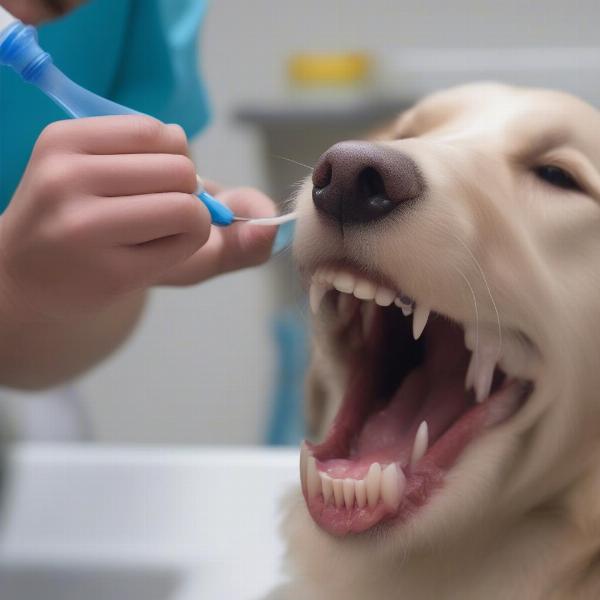Dental rinse for dogs is a valuable tool in maintaining their oral hygiene. While brushing remains the gold standard, a dental rinse offers additional benefits, reaching areas of the mouth that a toothbrush often misses. It can help freshen breath, control plaque and tartar buildup, and promote overall gum health. Choosing the right rinse and using it correctly is crucial for maximizing effectiveness and ensuring your dog’s safety.
Why Use a Dental Rinse for Dogs?
 Dog using dental rinse
Dog using dental rinse
Beyond simply freshening breath, dental rinse for dogs provides several key benefits:
- Reduces plaque and tartar: Many rinses contain ingredients that help break down and prevent the accumulation of plaque and tartar, the main culprits behind gum disease.
- Soothes gums: Some rinses have anti-inflammatory properties that can help soothe irritated gums and reduce discomfort.
- Fights bacteria: Dental rinses can kill harmful bacteria in the mouth, reducing the risk of infections and bad breath.
- Easy to use: For dogs who resist brushing, a dental rinse offers a convenient alternative or supplement to traditional brushing.
Choosing the Right Dental Rinse
Not all dental rinses are created equal. Look for rinses specifically formulated for dogs and avoid using human mouthwash, as it can contain ingredients toxic to pets. Consider the following when choosing a rinse:
- Ingredients: Look for rinses with chlorhexidine dental rinse for dogs, which has antibacterial and antiseptic properties, or benzethonium chloride dogs, another effective antiseptic. Avoid products containing xylitol, a sweetener that is extremely toxic to dogs.
- Flavor: Choose a flavor your dog will enjoy to make the experience more positive. Many rinses come in poultry or beef flavors.
- Veterinarian recommended: Look for rinses that have been approved by veterinary professionals.
How to Use Dental Rinse for Dogs
Introducing dental rinse should be a gradual process. Start by letting your dog lick a small amount from your finger to get accustomed to the taste. Once they are comfortable, follow these steps:
- Lift your dog’s cheek: Gently pull back the lip to expose the teeth and gums.
- Apply the rinse: Follow the instructions on the product label, usually pouring a small amount of rinse directly into the mouth or applying it with a syringe or finger brush. Ensure the rinse reaches all areas of the mouth.
- Do not rinse: Unlike human mouthwash, dog dental rinse does not need to be rinsed out. Allow it to remain in the mouth to work its magic.
What are the best oral antiseptics for dogs?
oral antiseptic for dogs such as chlorhexidine gluconate and benzethonium chloride are effective against bacteria that cause bad breath and gum disease.
What is Dentisept for dogs?
dentisept for dogs is a brand of oral rinse that contains chlorhexidine gluconate, an effective antiseptic for controlling plaque and gingivitis.
Conclusion
Dental rinse for dogs can be a valuable addition to your pet’s oral hygiene routine. By choosing the right rinse and using it correctly, you can help keep your dog’s breath fresh, teeth clean, and gums healthy. Regular use of dental rinse, along with brushing and professional cleanings, can significantly improve your dog’s overall oral health and prevent serious dental problems down the road.
FAQ
- How often should I use dental rinse on my dog? Most dental rinses can be used daily or as directed by your veterinarian.
- Can I use human mouthwash on my dog? No, human mouthwash often contains ingredients that are toxic to dogs, such as xylitol. Always use a rinse specifically formulated for dogs.
- What if my dog swallows the dental rinse? While small amounts are generally safe, if your dog ingests a large amount of dental rinse, contact your veterinarian immediately.
- Are there any side effects of using dental rinse for dogs? Some dogs may experience mild gastrointestinal upset if they swallow a large amount of rinse. If you notice any unusual symptoms, discontinue use and consult your veterinarian.
- Can dental rinse replace brushing my dog’s teeth? While dental rinse is beneficial, it should not replace regular brushing. Brushing remains the most effective way to remove plaque and tartar.
- My dog hates having his teeth brushed. What can I do? Try introducing brushing gradually and using positive reinforcement. Dental rinse can be a helpful supplement for dogs who resist brushing.
- Where can I buy dental rinse for dogs? Dental rinse for dogs is available at most pet stores and online retailers.
Related Articles
About ILM Dog
ILM Dog is your trusted international resource for all things canine. We offer expert advice on dog breeds, health, training, nutrition, grooming, and much more. Whether you’re a seasoned dog owner or just starting your journey, we’re here to provide practical, reliable information to help you care for your furry friend. From choosing the right breed to understanding your dog’s health needs, ILM Dog is your go-to source. Contact us for further advice: [email protected] or +44 20-3965-8624.